

 Vol. 38 (Nº 25) Year 2017. Page. 18
Vol. 38 (Nº 25) Year 2017. Page. 18
Vladimir Sergeyevich ARTAMONOV 1; Alexander Yuryevich IVANOV 2; Sergey Vladimirovich SHARAPOV 3; Elena Nikolaevna TROFIMETS 4; Valeriy Yaroslavovich TROFIMETS 5;
Received: 09/03/2017 • Approved: 15/04/2017
ABSTRACT: The guidelines of the informational support for analytical training of management scholars are considered. A comparative analysis of software systems focused on accounting and clearing functions and software systems focused on functional analytical tasks was carried out. The didactic features of the application of educational programmed and methodological tools of procedure type are viewed. The method of evaluating the didactic effectiveness of education programmed and methodological tools based on the method of two-way repeated measures analysis of variance is offered. The testing of the methods is carried out on the data of pedagogical experiments that were set in the process of analytical training of management scholars using information technology. |
RESUMEN: Se consideraron las directrices del apoyo informativo para la formación analítica de académicos de gestión. Se realizó un análisis comparativo de sistemas de software enfocados en funciones de contabilidad, compensación y sistemas enfocados en tareas analíticas funcionales. Se examinan las características didácticas de la aplicación de herramientas educativas programadas y metodológicas de tipo procedimiento. Se ofrece el método de evaluación de la efectividad didáctica de las herramientas programadas y metodológicas de educación basadas en el método de análisis de varianza de medidas repetidas bidireccionales. La prueba de los métodos se lleva a cabo sobre los datos de los experimentos pedagógicos que se establecieron en el proceso de formación analítica de los académicos de gestión utilizando la tecnología de la información. |
One of the priority directions of modern development of universities is the adoption of information technology (IT) and its wide use in the educational process. At the same time, as a rule, there are two primary objectives:
1. Improvement of the quality of specialists training in various academic subjects by the enhancement of educational technology using IT.
2. Information and communication environment modelling for future professional activity while using IT.
The adoption of IT in the educational process implements the paradigm of computer-aided learning that has been studied in many scientific papers which deal with various aspects of this multifaceted process – technical, programmed, psychological, didactic, and ergonomic (Solovov, 1995; Obraztsov, 2000; Bashmakov, & Bashmakov, 2003; Zolotarev, 2009; Cruz-Cunha et al., 2011; Pontes et al., 2012; Bowen, 2013 and others).
From the very beginning, in terms of methodology, technology-aided learning developed in two guidelines.
The first one is closely related to the primary goal of the adoption of IT in the educational process and is based fundamentally on the idea of programmed instruction (Bespalko, 1970). Within this framework, education programmed and methodological tools are developed and operated; the main of them are: computer-based tutorial; computer based training manual; computer-based laboratory work; computer-based test for academic performance and others.
The second direction for the development of computer-aided learning technologies is closely linked with the second aim of the adoption of IT in the educational process and is based on the use of software products aimed to the application of professional tasks that were not originally intended for use in the educational process.
The creation of computerized learning technologies began in the USSR in the mid-sixties, but only after the advent of personal computing they got widespread use in the educational environment. Currently, computerized learning technologies are applied successfully in all areas of management scholars. Their role in the study of analytical data processing technology has increased significantly in the last decade (Alekseeva et al., 2005; Perner, 2010; Paklin, & Oreshkov, 2013; Larose, & Larose, 2015 and others).
The first direction for the development of computer-aided learning technologies (improvement of the quality of specialists training in various academic subjects) is dominant in the study of natural sciences, humanitarian and general professional subjects; the second direction (information and communication environment modelling for future professional work) is the main one in the study of special subjects.
Within the first direction, the computer-based system of infoware for lectures, tutorials, training manuals and tests for academic performance are widely used. A variety of software products are used for the development of data of programmed and methodological tools, the main ones are: slidewares and programs for organization charts, painting and drawing programs, programs for making demo clips, programs for making tests, the html-editors, programming languages and systems, etc. Author’s development systems making it possible to develop complex interactive multimedia applications are widely used. These systems not only support the various components of the information (text, graphics, audio, and video) but also make it possible to organize the various scenarios of learning material as well as offer a wide range of types and methods of control of learners’ actions, provide the computer-based analysis of learning outcomes.
Within the second direction, the software systems are being studied that can be divided into the following two categories:
• software systems aimed at performance of professional tasks of accounting and clearing functions;
• software systems aimed at performance of professional analytical tasks.
When choosing a methodology for the study of given software systems, the following didactic principles are taken into account (Trofimets, 2010):
• training should be based on information model of internal and external environment whereby the system will be operated;
• training should be conducted in the context of future professional activity when the task reflects one side of a future profession. The purpose of teaching is to learn to perform professional tasks using the selected system, and not just to master the techniques of working with it;
• training should be conducted in close collaboration with the related educational subject.
The defined foundations of teaching to work with professional software systems are easy enough implemented for software systems in the first category; software systems in the second category are implemented much more difficult. This fact can be explained, apparently, by the following reasons:
1. The software systems in the first category focused on professional tasks performance in “determinated management domain”, i.e. in the domain which is quite strictly regulated by various normative documents and rules. The tasks of this domain have accounting and clearing functions whereby the calculated component is limited, as a rule, to the standard arithmetic, statistical or logical operations. In addition, the tasks of this domain appear repeatedly, they are not unique by nature and they are performed according to common standards and normative documents.
The software systems in the second category are focused on professional tasks performance in "non-determinated management domain", i.e. in the domain that is exposed to random factors and has a considerable degree of uncertainty. The tasks of this domain are analytical, they are often unique by nature and their solutions often need to use complex mathematical tools technique.
2. A certain virtual account policy and workflow system, to which a typical configuration of the program is set up, act as an information model of the environment for software systems in the first category. If the actual account policy or workflow system is different from the virtual one the adaptation of the program is carried out by adjusting its configuration. The great experience of the operation of programs in the first category has shown the effectiveness of this approach; therefore, software products of instrumental type or, in other words, program-designers have a dominant position in the market of management software systems of the first category.
A certain virtual situation described by a set of information flows acts as an information model of the environment for software systems in the second category. If the actual situation is different from a virtual one then the adjustment of the situation to the program is carried out in contrast to the first category of software systems. This is due to the fact that the information models of software products in the second category have much greater diversity than the software products in the first category, that is why it is difficult and sometimes impossible to predict all the possible states of the information model and, as a consequence, to develop appropriate mechanisms of adoption.
3) The study of the programs in the first category is based on the academic subjects that are more pronounced and have an applied and, as a rule, factual nature, which is directly reflected in the relevant software products. The study of the programs in the second category is based on the academic subjects that have a fundamental, usually mathematical nature, the methodological essence of which is often hidden from the users of the program.
The revealed significant differences between the software systems in the first and second categories are responsible for the choice of different approaches for studying them.
The software systems in the second category are part of the information-analytical training of management scholars, which is much more difficult in its essence and content of the information than basic information training and training for professionally-oriented software products in the first category. The complexity of information-analytical training is explained, firstly, by its knowledge-intensive nature; secondly, by large variety of mathematical models, methods, and software products used in the practice of management; thirdly, by uniqueness of the tasks when the available software often insufficient for their performance.
Thus, on the one hand, there are the increased requirements of practice for the content of information-analytical training of management scholars; on the other hand, the delay of educational information technologies in this sphere is obvious. This contradiction motivates the need in the development of existing and new approaches to the organization of information-analytical training of management scholars in universities.
The growth of interest in learning through education software methodological support (UPMS) has led to the identification of its discontinuity. In the study of the problems of methodology, it was suggested to distinguish tacit and implicit knowledge (Polanyi, 1958). Later on, with the development of studies in the sphere of artificial intelligence, this knowledge became known as articulated and non-articulated (Shapiro, 1990).
The articulated part of knowledge can be easily structured and imparted to a student with the help of some pieces of information (text, graphics, video, etc.).
Software and methodological tools used to support the process of acquisition of the articulated knowledge are declarative. They include: computer-based tutorial; computer-based information system for lectures; computer-based training courses; computer-based tests for academic performance and other software and methodological tools allowing to store, transmit and check the accuracy of educational information acquisition by students.
The non-articulated part of the knowledge is the knowledge component based on experience and intuition. This part covers abilities, skills, intuitive images and other forms of human experience which cannot be transferred directly to the learner, but he or she gets them by themselves during the cognition activity when performing some practical tasks.
Software and methodological tools used to support the process of acquisition of the non-articulated knowledge are procedural. Software and methodical means of procedural type do not contain knowledge materialized in the form of information; they are based on models that allow the student in the course of the determined or free academic study to gain knowledge about the properties of the studied objects or processes. Procedural software and methodological tools include: computer-based training manual; computer-based laboratory works; applications that implement a specific model or allow to design a model; computer-based software simulators and other software methodological support that allow the student to gain knowledge in the studied topical area.
It should be noted that the classification of education software and methodological support for declarative and procedural ones is not strict. In the same software and methodological tool, we can separate out a declarative and a procedural component, so in this case it is necessary to talk about the domination of one component over another. For example, a computer-based training manual in which the procedural component is clearly dominated can be provided with instructions for the sequence of actions in performing typical tasks. In this case, the student gets ready information about the process of task performance and thus acquires declarative knowledge.
In the information-analytical training of management scholars, the most effective software and methodological tools became those with a dominant procedural component. Among them, the applications that implement some pre-integrated models and methods for professional activity, as well as applications that enable to construct models and methods of professional activity (program-designers), were widely used.
Despite the undoubted usefulness of applications in the first type their adoption does not always lead to the improvement of the quality of the actual analytical training. Students do not gain full insight about the essence of the methods implemented in the program which is shown in distrust in the results obtained; hence an uncertain program use. Sometimes, the secrecy of computational procedures in the program brings more harm than good to the analytical training. Many calculations which, at first glance, appear to be routine work have a great learning effect, as they allow to follow and understand the link of the analyzed indicators of the object (process) with varying variables.
Thus, despite the high didactic potential in the first type of application, in many cases it is not fully implemented, as it requires prior interpretation used in applications of mathematical methods and models on a more “tangible” level. This level can be achieved by modeling the appropriate models (methods) in the “transparent” environment that program-designers can provide.
By didactic effectiveness of education software and methodological tools (UPMS) is meant the effect of their application for achieving the desired learning goals; this effect shows a positive increment of the achieved result compared to the previous results taking into account the time, technical, didactic and psycho-physiological factor (Obraztsov, 2000).
At present, two main approaches to the evaluation of didactic effectiveness of UPMS are widely used. The first approach involves the questioning of students on the impact of UPMS on the quality of learning. The second approach involves the formulation of the pedagogical experiment and development methods to quantify didactic effectiveness of UPMS. Let us consider the second approach.
A pedagogical experiment is usually performed to obtain didactic quantitative assessments. Almost all of the known pedagogical experiments to evaluate didactic effectiveness of UPMS have a similar idea – a comparison of two groups of students is carried out, one of which was trained using the tested UPMS, another was trained without using it.
A similar pedagogical experiment as a part of the training sessions on “Computational Mathematics” subject was carried out in the St. Petersburg University of State Fire Service of EMERCOM of Russia. The experimental and control groups were formed and consisted of six study groups so that they have the learners with about the same level of mathematical foundation (20 learners with high, medium and low levels of mathematical foundation are in each group). The formation of such groups was based on the marks in “Higher Mathematics” subject. Checking the homogeneity of the formed groups was carried out with the help of Mann-Whitney U-test (Agresti, & Finlay, 2008).
When planning the experiment, an assumption was made about the impact on the quality of the learning of two factors: mathematical foundation of students and learning technology (with and without the use of a computer training manual). To maximize the exclusion of other factors, the training course in study groups was conducted by the same teacher for similar procedures, except that cadets in three study groups used the developed computer training material (of which the experimental group was formed).
The quality control test of knowledge of cadets in the experimental and control groups was carried out during the final practical exercises and laboratory works. A scale of one to ten was used during the experiment. There was a correlation between the scores of this scale and the traditional five-point grading scale in Table 1.
Table 1. Correlation between two scales
|
Scale of one to ten |
Scale of one to five |
10 |
5+ |
9 |
5 |
8 |
5- |
7 |
4+ |
6 |
4 |
5 |
4- |
4 |
3+ |
3 |
3 |
2 |
3- |
1 |
2 |
After training course in the study groups, the final marks of students were summarized in a statistical complex, for processing of which some mathematical statistics methods were used.
In the practice of educational research, parametric and nonparametric methods of testing of statistical hypothesis that are based on calculation procedures of tests are widely used. Parametric criteria include Student's t-test, Walsh test, Cochran's and Cox test, Polson test and other tests; nonparametric criteria are Mann-Whitney test, Quenoulle test, van der Waerden test, Hagi test, etc. (Prokhorov, 1999; Kobzar', 2006). Non-parametric methods are used when there is lack of reasons to put forward an assumption about normal distribution of data to be processed. The advantages of these methods should also include the fact that they do not require complex computational calculations. In the case when there are reasonable grounds to assume a normal distribution of study groups the parametric methods should be used, as they have greater statistical power in comparison with the non-parametric methods. Furthermore, some of these techniques, in particular, the analysis of variance, allow to carry out a deeper study of the compared groups (Scheffe, 1959; Montgomery, 2001).
Testing the hypothesis of normal distribution of the studied groups was performed using c2 criterion (Pearson’s goodness-of-fit test). At the level of significance a = 0.05, a suggested hypothesis was maintained that allowed to use the parametric methods for further study. So, the analysis of variance was chosen; its value for the studies is that it allows not only to confirm (or refute) the difference between the compared groups but also to determine a resultant action of factors, the action of each controlled factor in the experiment, as well as the action of different combinations of factors on a successful condition. Since the experiment took into account the impact of two factors (the level of mathematical foundation of students and the availability of innovative technologies of learning), the two-way analysis of variance was used.
The logic of the two-way analysis of variance is similar to the logic for a single factor analysis of variance, and is as follows.
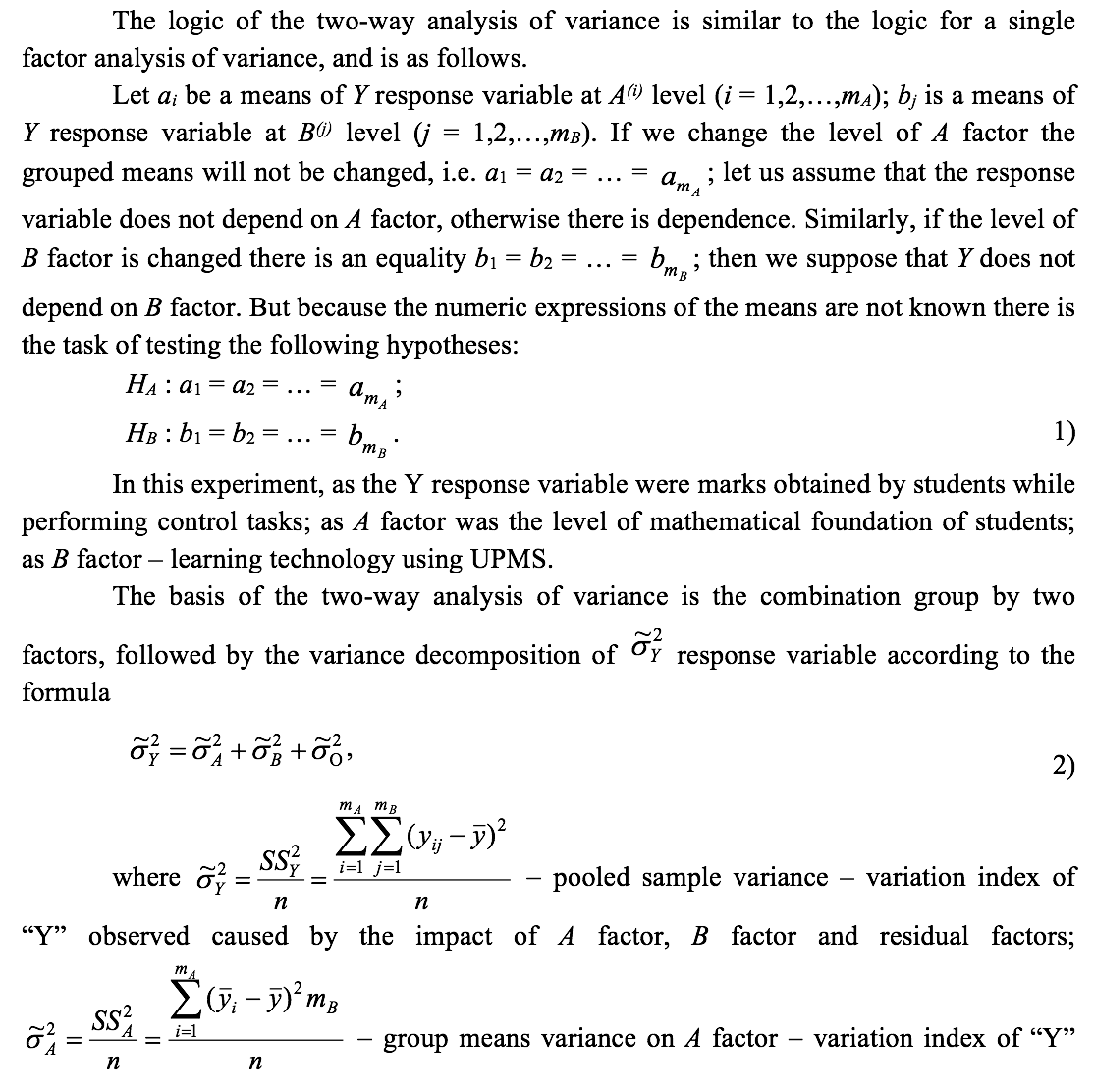
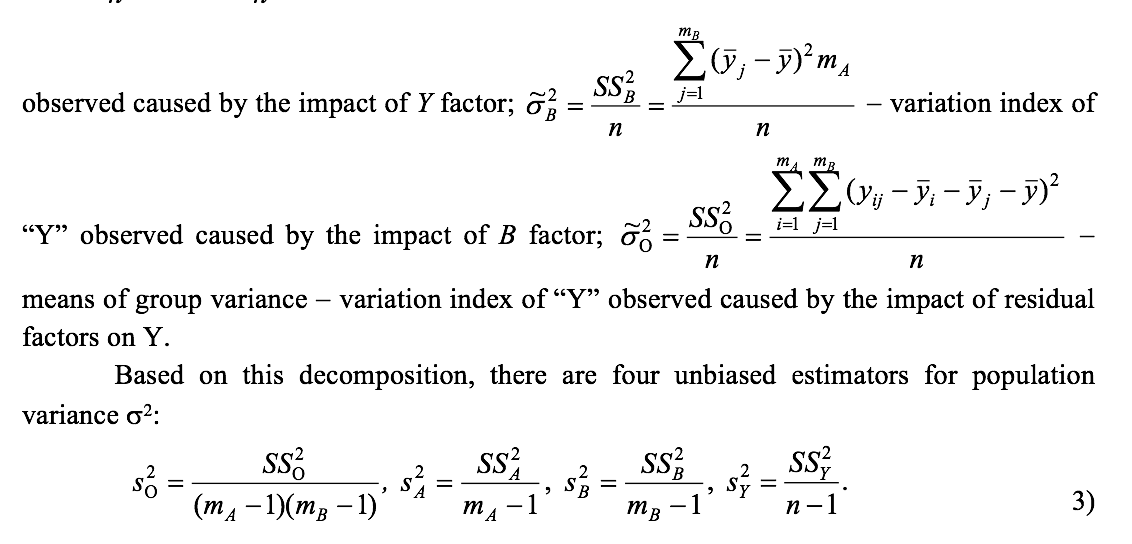
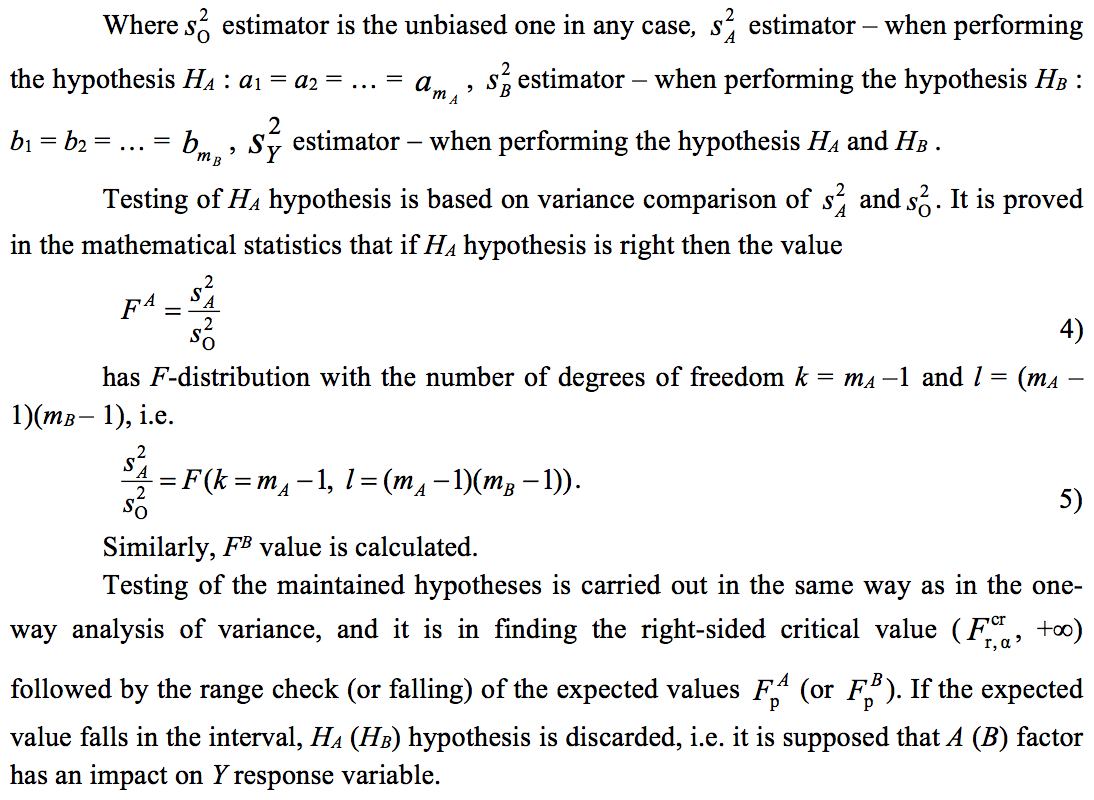
The two-way analysis of variance can have two varieties: with repeated measures and without repeated measures. In the first case, only one data sample corresponds to each level of the factor; in the second case, more than one data sample corresponds to certain levels of the factors. To improve the reliability of the results in this experiment, the method of the two-way analysis of variance with repeated measures was used.
Pedagogical experiment results were summarized in the statistic complex with the following characteristics:
· A factor – the level of mathematical foundation;
· B factor – learning technologies using UPMS;
· mA – the number of scales of A factor (mA = 3 – high, medium, low);
· mB – the number of scales of B factor (mB = 2 – using the training manual, without using it);
· n – the number of cases in “separate” cells of cross-table, i.e. the number of cases for one scale of A and B factors (n = 20);
· nA – the number of cases in the scales of A factor (nA = mB ´n = 2´20 = 40);
· nB – the number of cases in the scales of B factor (nB = mA ´n = 3´20 = 60);
· N – the total number of cases (N = mA´mB´n = 3´2´20 = 120);
· xi – cases that are included in variance pool (indexing i from up to down, from right to left).
The formed statistic complex was processed according to the following algorithm:
1. Finding the total sum of squared derivations:
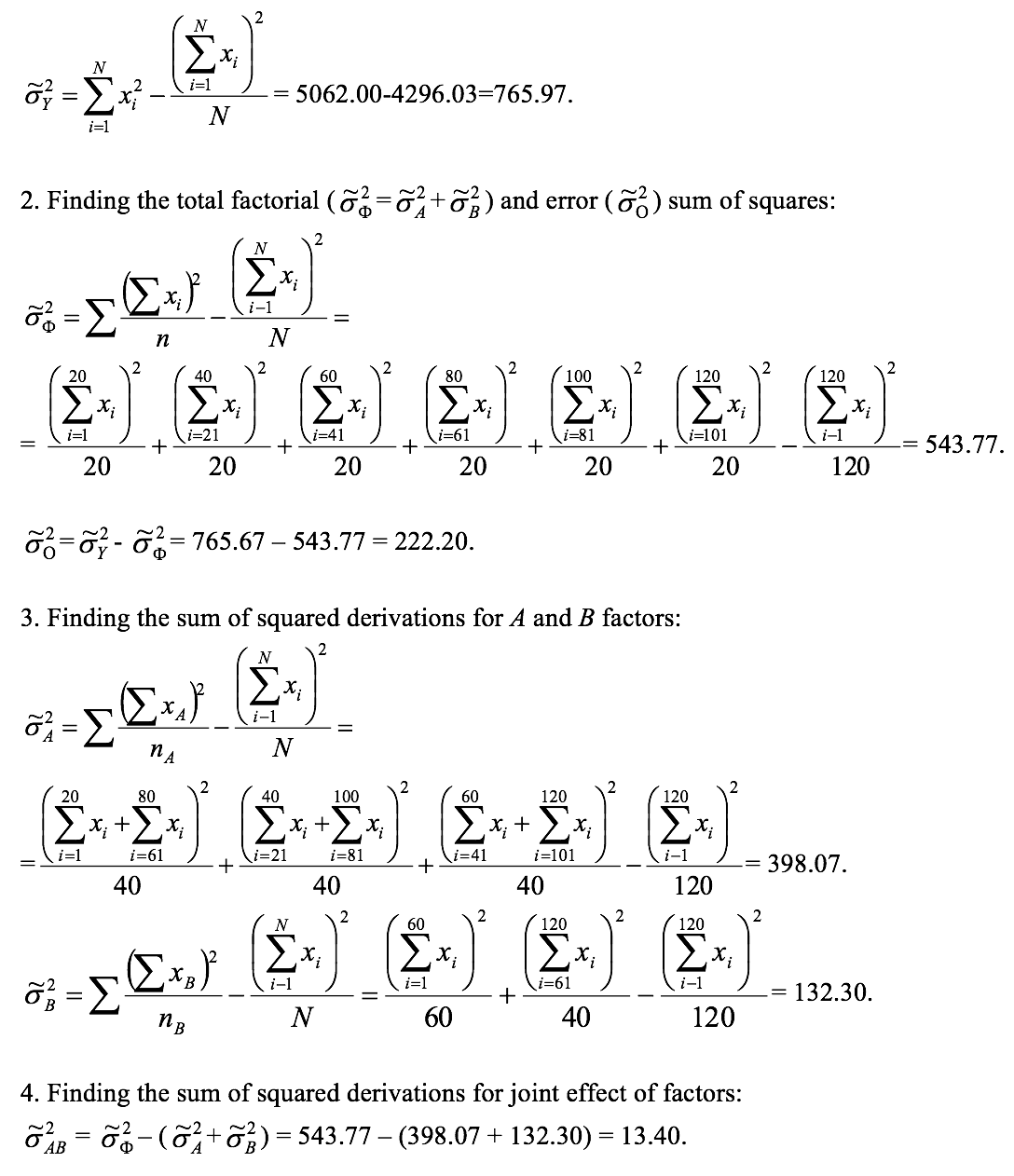
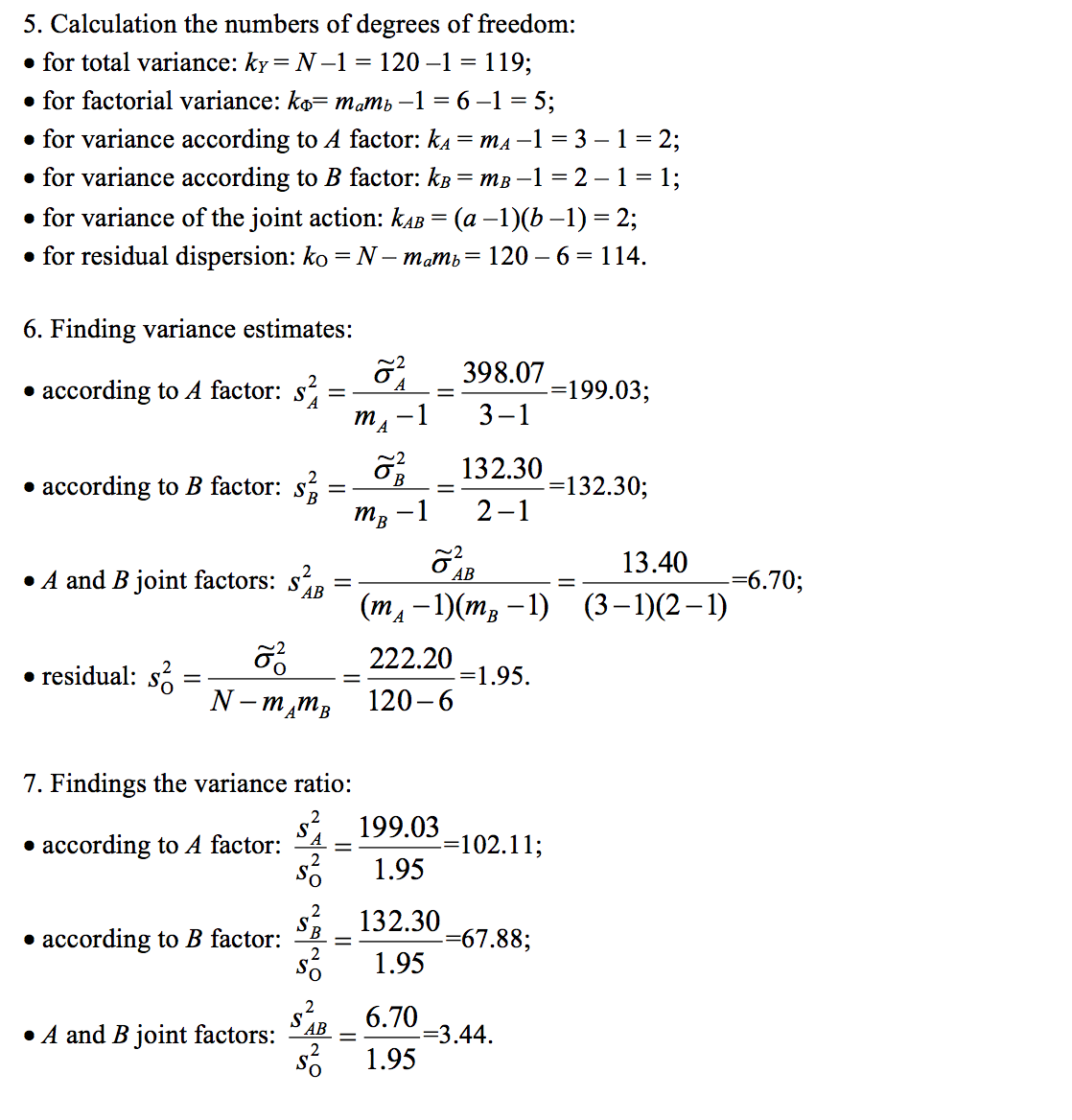
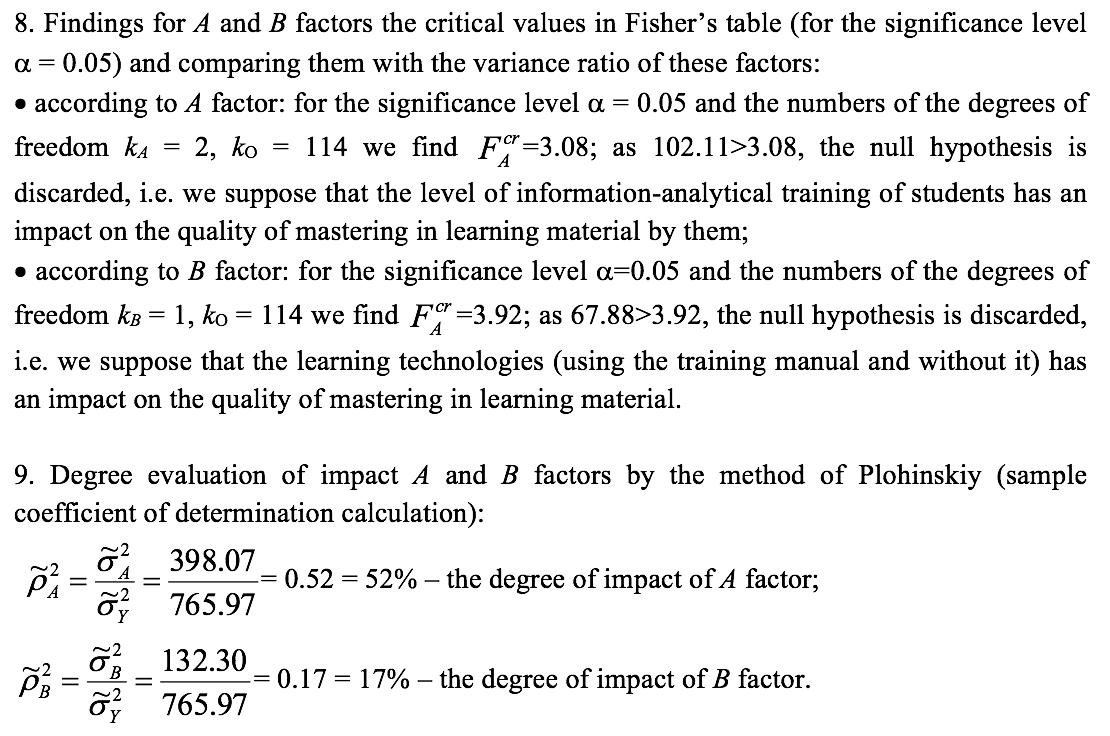
A specialized statistics package (Statistica, SPSS, SAS, StatGraphics, etc.) or MS Excel “Analysis Package” software add-in can be used for reducing working time of processing the statistic complex (Tyurin, & Makarov, 1998; Makarova, & Trofimets, 2006; Abbott, 2016).
Analyzing the results of the statistic complex processing, we can state that about 52% of the total sample variation evaluation is linked with the impact of the level of mathematical foundation of students and about 17% – with the effect of learning technologies (the remaining 32% comes from the action of unaccounted factors in the experiment). Thus, we can conclude that the use of education software and methodological support in information-analytical training of management scholars has a significant positive effect on the quality of learning.
It should also be noted that in the development of education software and methodological tools it is advisable to take into account the psychological mechanisms of acquisition of knowledge allowing to increase the effectiveness of the learning process. The best known psychological mechanisms of acquisition of knowledge are: behavioral learning theory, associatively reflex theory of acquisition, the theory of gradual formation of mental actions, the theory of the formation of algorithmic thinking, the theory of the formation of lateral thinking (Bono, 1997).
When designing didactic education software and methodological tools supporting the non-articulated part of knowledge, the theory of the formation of algorithmic (system) thinking and the theory of the formation of the lateral (creative) thinking are of interest. In psychological, studies creative thinking is associated with an associative mechanism and intuition, and systems thinking – with a generalization mechanism. These mechanisms are fundamentally different, but there is an interaction between them multiplying of which gains a positive effect; it is shown in the activities of experts, consultants, analysts with many years' experience (Bono, 1997; Kuzhel', & Kuzhel', 2002). The paper (Kuzhel', & Kuzhel', 2002) shows that the increased interaction between the associative mechanism and the mechanism of generalization has a significant positive effect in the learning process. As a means of enhancing the interaction between the thinking mechanisms, the learning through simulation is considered. Experimental simulation-based learning has shown that this technology allows to form such abilities of students (thinking characteristics) as to analyze (49% of respondents participating in the survey), to systemize (28%), to summarize the studied material and to draw conclusions (45%), to think by themselves (26%) and others. This is evidenced by the fact that working with professional-oriented analytical tasks students had to take some unconventional creative solutions (28% of respondents – in full, and 29% – to some extent).
Thus, the learning environment created by the education software and methodological tools of procedural type not only supports the process of the acquisition of the non-articulated part of knowledge, but also contributes to the development of system and creative thinking of the students.
The modern paradigm of training of management scholars is based on two main views on modern management and, accordingly, two main approaches to its development – an empirical approach (or approach of adaptations and analogies) and an analytical (or rational) approach. The randomness and uncertainty inherent in the analytical control tasks, in our view, complicate the use of the first approach for their solution; and they determine the utility of the active use of the second one, so the abilities to apply the methods of system analysis, forecasting, decision-making and, as a consequence, the ability to work skillfully with information technologies of decision-making support are of key importance for the specialists in this sphere. In this case, an analytical expert can be represented as a certain designer capable of creating a problem-solving scheme based on the existing software instrumented systems by coordination of their inputs and outputs. The missing links in the scheme for task performance are to be transcribed directly by an analytical expert or by a specialist in computer-aided data processing. In the second situation, an analytical expert serves as a problem originator.
Abbott, M.L. (2016). Using Statistics in the Social and Health Sciences with SPSS and Excel. Herausgeber: Wiley.
Agresti, A., & Finlay, B. (2008). Statistical Methods for the Social Sciences. Southern California: Prentice Hill.
Alekseeva, T.V., Luzhetskiy, M.G., & Kurganova, E.V. (2005). Informatsionno-analiticheskie sistemy [Information-Analytical Systems]. Moscow: MFPA.
Bashmakov, A.I., & Bashmakov, I. A. (2003). Razrabotka komp'yuternykh uchebnikov i obuchayushchikh sistem [Development of Computer-Aided Manuals and Educational Systems]. Moscow: Filin.
Bespalko, V.P. (1970). Programmirovannoe obuchenie: didakticheskiy aspect [Computer-Aided Learning: Didactic Aspect]. Moscow: High school.
Bono, E. (1997). Lateral'noe myshlenie [Lateral Thinking]. Saint Petersburg: Piter Publishing.
Bowen, W.G. (2013). Higher Education in the Digital Age. Princeton University Press.
Cruz-Cunha, M.M., Varvalho, V.H.C., & Tavares, P.C.A. (Rds.). (2011). Computer Games as Educational and Management Tools: Uses and Approaches. IGI Global.
Kobzar’, A.I. (2006). Prikladnaya matematicheskaya statistika. Dlya inzhenerov i nauchnykh rabotnikov [Applied Mathematical Statistics. For Engineers and Scientists]. Moscow: Fizmatlit.
Kuzhel, S.S., & Kuzhel, O.S. (2002). Informatsionnye tekhnologii – sredstvo razvitiya sistemnogo tvorcheskogo myshleniya [Information Technologies – the Means of Development of System Creative Thinking]. Educational Technology & Society, 1: 264-275.
Larose, D.T., & Larose, C.D. (2015) Data Mining and Predictive Analytics. Herausgeber: Wiley.
Makarova, N.V., & Trofimets, V.Ya. (2002). Statistika v Excel [Statistics in Excel]. Moscow: Finance and Statistics.
Montgomery, D.C. (2001) Design and Analysis of Experiment. Herausgeber: John Wiley & Sons.
Obraztsov, P.I. (2000). Psikhologo-pedagogicheskie aspekty razrabotki i primeneniya v vuze informatsionnykh tekhnologiy obucheniya [Psychological and Pedagogical Aspects of Development and Adoption of Education Information Technologies in Universities]. Orel: OGTU.
Paklin, N.B., & Oreshkov, V.I. (2013). Biznes-analitika: ot dannykh k znaniyam [Business Analytics: from Data to Knowledge]. Saint Petersburg: Piter.
Perner, P. (2010) Advances in Data Mining: Applications and Theoretical Aspects. New York: Springer.
Polanyi, M. (1958) Personal Knowledge: Towards a Post-critical Philosophy. London: Routledge & Kegan Paul.
Pontes, E., Silva, A., Guelfi, A., & Kofuji, S.T. (Eds.) (2012) Methodologies, Tools and New Developments for E-Learning. Croatia: InTech.
Prokhorov, Y.V. (1999). Veroyatnost' i matematicheskaya statistika. Entsiklopediya [Probability and Mathematical Statistics. Encyclopedia]. Moscow: Big Russian Encyclopedia.
Shapiro, E.L. (1990). Komponenty znaniy i ikh sootnoshenie v sferakh intellektual'noy deyatel'nosti [Knowledge Components and Its Ratio in Spheres of Intellectual Activity. Journal of Higher School, 11: 26-31.
Scheffe, H. (1959) The Analysis of Variance. Herausgeber: Wiley.
Solovov, A.V. (1995). Proektirovanie komp'yuternykh sistem uchebnogo naznacheniya [Design of Computer Systems for Educational Purposes]. Samara: SGAU.
Trofimets, E.N. (2010). Informatsionno-analiticheskie tekhnologii obucheniya menedzherov v obrazovatel'nykh uchrezhdeniyakh Rossii i za rubezhom [Information and Analytical Technologies of Managers Teaching in Russian and Foreign Universities]. Bulletin of Russian Peoples Friendship University. Series: Informatization of Education, 1: 86-95.
Tyurin, Y.N., & Makarov, A.A. (1998). Statisticheskiy analiz dannykh na komp'yutere [Computer-Aided Statistical Analysis of Data]. Moscow: INFRA-M.
Zolotarev, A.A. (2009). Teoriya i metodika sistem intensivnogo informatizirovannogo obucheniya (Didakticheskie osnovy sozdaniya effectivnykh sistem obucheniya) [Theory and Methodology of Systems of Informational Support Intensive Education (Didactic Foundations for Effective Systems of Education): Tutorial]. Moscow: MGIU.
1. Russian Ministry for Civil Defense, Emergencies and Elimination of Consequences of Natural Disasters, Russia, 109012, Moscow, Teatralny prospect, 3.
2. Saint Petersburg University of State Fire Service of Emercom of Russia, Russia, 196105 Saint Petersburg, Moskovsky prospectus, 149
3. Saint Petersburg University of State Fire Service of Emercom of Russia, Russia, 196105 Saint Petersburg, Moskovsky prospectus, 149
4. Saint Petersburg University of State Fire Service of Emercom of Russia, Russia, 196105 Saint Petersburg, Moskovsky prospectus, 149
5. Saint Petersburg University of State Fire Service of Emercom of Russia, Russia, 196105 Saint Petersburg, Moskovsky prospectus, 149
Contact Email: malygin_com@mail.ru